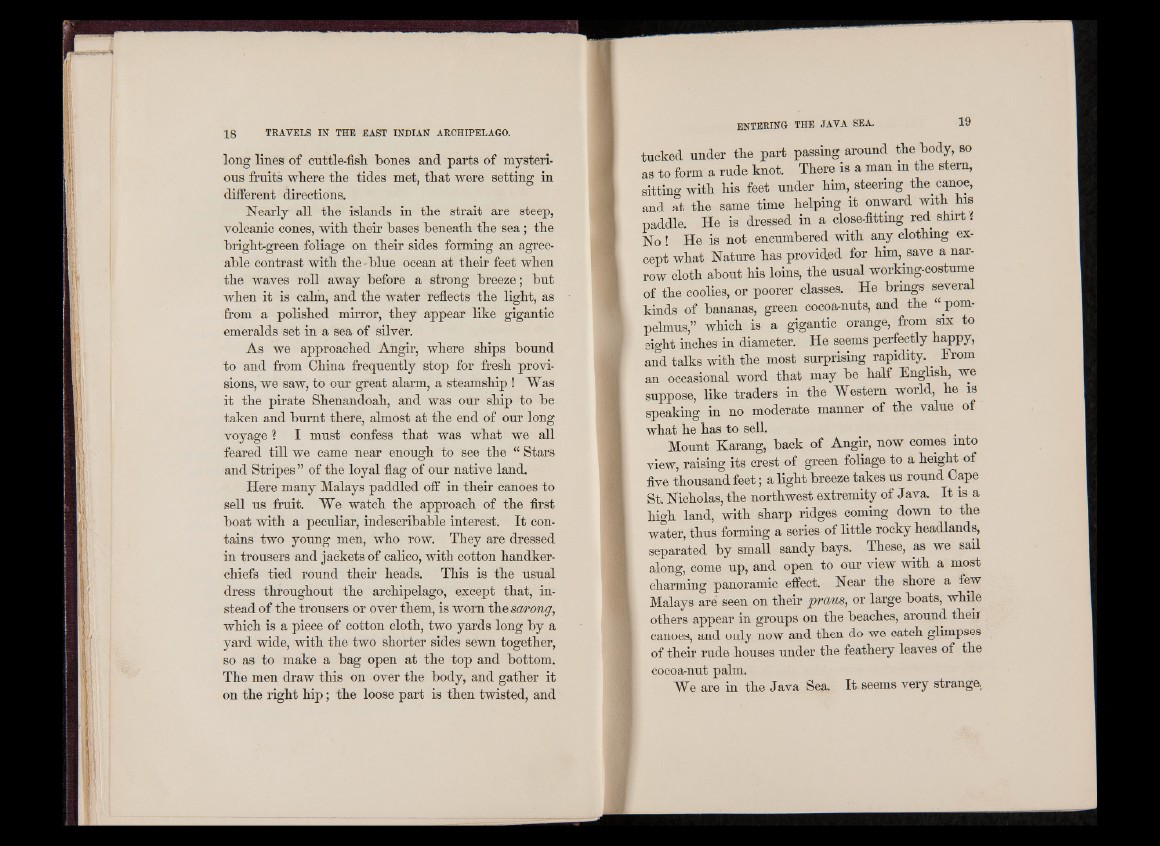
long lines of cuttle-fish, bones and parts of mysterious
fruits where the tides met, that were setting in
different directions.
Nearly all the islands in the strait are steep,
volcanic cones, with their bases beneath the sea; the
bright-green foliage on their sides forming an agreeable
contrast with the -blue ocean at their feet when
the waves roll away before a strong breeze; but
when it is calm, and the water reflects the light, as
from a polished mirror, they appear like gigantic
emeralds set in a sea of silver.
As we approached Angir, where ships bound
to and from China frequently stop for fresh provisions,
we saw, to our great alarm, a steamship ! Was
it the pirate Shenandoah, and was our ship to be
taken and burnt there, almost at the end of our long
voyage ? I must confess that was what we all
feared till we came near enough to see the “ Stars
and Stripes” of the loyal flag of our native land.
Here many Malays paddled off in their canoes to
sell us fruit. We watch the approach of the first
boat with a peculiar, indescribable interest. It contains
two young men, who row. They are dressed
in trousers and jackets of calico, with cotton handkerchiefs
tied round their heads. This is the usual
dress throughout the archipelago, except that, instead
of the trousers or over them, is worn the sa/rong,
which is a piece of cotton cloth, two yards long by a
yard wide, with the two shorter sides sewn together,
so as to make a bag open at the top and bottom.
The men draw this on over the body, and gather it
on the right h ip ; the loose part is then twisted, and
ENTERING THE JAVA SEA. 19
tucked under the part passing around the body, so
as to form a rude knot. There is a man in the stem,
sitting with his feet under him, steering the canoe,
and at the same time helping it onward with his
paddle. He is dressed in a close-fitting red sh irt.
No ! He is not encumbered with any clothing except
what Nature has provided for him, save a narrow
cloth about his loins, the usual working-costume
of the coolies, or poorer classes. He brings several
kinds of bananas, green cocoa-nuts, and the “ pom-
pelmus,” which is a gigantic orange, from six to
eight inches in diameter. He seems perfectly happy,
and talks with the most surprising rapidity. ; From
an occasional word that may be half English, we
suppose, like traders in the Western world, he is
speaking in no moderate manner of the value of
what he has to sell.
Mount Karang, back of Angir, now comes into
view, raising its crest of green foliage to a height of
five thousand feet; a light breeze takes us round Cape
St. Nicholas, the northwest extremity of J ava. I t is a
high land, with sharp ridges coming down to the
water, thus forming a series of little rocky headlands,
separated by small sandy bays. These, as we sail
along, come up, and open to our view with a most
charming panoramic effect. Near the shore a few
Malays aré seen on their praus, or large boats, while
others appear in groups on the beaches, around theil
canoes, and only now and then do we catch glimpses
of their rude houses under the feathery leaves of the
cocoa-nut palm.
We are in the Java Sea. It seems very strange.